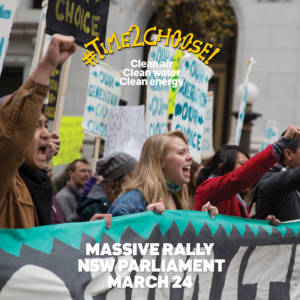This piece was originally published in the Newcastle Herald.
By Blair Palese
Clean land, water and energy should not be an aspirational dream for the people of NSW.
Communities should not have to fight to protect their health, livelihood, environment and heritage from the impacts of coal and coal seam-gas mining but sadly, that’s exactly what many people across NSW are facing right now.
Despite community opposition and what we know about climate change and the need to move rapidly from coal and gas, government seems determined to remain on its entrenched path of expansion of the fossil fuel industry to replace the state’s aging energy infrastructure. Over the next year, key decisions will determine if NSW continues turning some of our most fertile and valued land over to more destructive coal and gas mining, or if we choose a different path and begin the transition to a sustainable future. There’s a worrying list of proposed fossil fuel projects hanging in the balance.

The latest super-pit in the Hunter Valley, United Wambo, is being reviewed by the Independent Planning Commission (IPC), with a report on the Commission’s findings expected at the end of March. The mine will clear a large area of a nationally critically endangered forest that exists only in the Hunter. The IPC may also make a decision mid-year on Korean company KEPCO’s proposed mine in the Bylong Valley, a beautiful and secluded part of the Hunter which has never before been mined.
The mine is set to damage historic Tarwyn Park, which has state significant heritage value and is the living laboratory where Peter Andrews developed his unique Natural Sequence Farming system of regenerative agriculture. The mine would also cause 10 metres drawdown in the productive Bylong alluvial aquifer, putting its viability at risk along with the agricultural production it supports.
A Land and Environment court decision is pending in the case Wollar Progress Association brought against Peabody’s Wilpinjong mine extension in the upper reaches of the Hunter. The group argued that the NSW Planning Assessment Commission failed to consider greenhouse gas emissions when it approved the expansion in April 2107.
Further north west, the exploration licence for Shenhua’s Watermark coal mine on the Liverpool Plains expired in 2016. Renewal of the licence is expected any time and would pave the way for the mine to proceed. Finally, towards the end of the year, it will be time to choose whether NSW will allow Santos to develop an 850 well coal seam gas field in the Pilliga forest, drilling through a recharge aquifer of the Great Artesian Basin and putting it at risk of drawdown, depressurisation and contamination.
The future of our state hangs on these decisions. In the coming months, we need to send a clear message to NSW politicians now to protect our land, our water, our community’s health and our cultural heritage. We need our future to be based on clean, renewable energy, not polluting coal and gas.
Every week the evidence mounts that coal has no future. Climate records are broken monthly. The recent spate of extreme cold in Europe, while the Arctic experienced temperatures up to 20 degrees higher than normal, is yet more evidence our climate is changing. Making the transition away from coal and coal-seam gas needs to begin as soon as possible. And it begins with choices. It’s time to choose. Thousands of people from around the state will be taking this message to Macquarie Street on March 24 for the #Time2Choose rally.
I urge you to join us.
What: #Time2Choose rally
When: Saturday 24 March, 12:00pm to 2:00pm
Where: Sydney CBD – Hyde Park North
